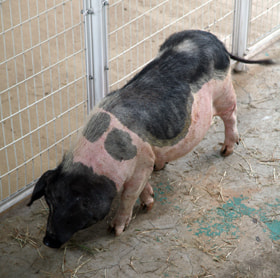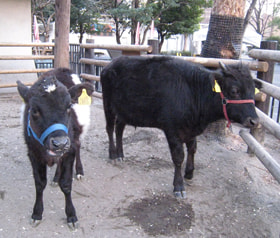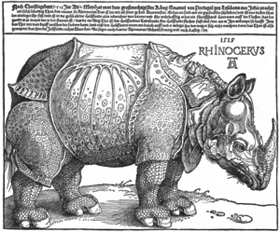
"Sea of polar bears and seals" that opened on October 28, 2011

Teruyuki Komiya, the former director of the Ueno Zoo (the incumbent managing director of Tokyo Zoological Park Society)
We talked with Teruyuki Komiya, the former director of the Ueno Zoo (the incumbent managing director of Tokyo Zoological Park Society).
Q: In recent years, zoos have made a strong effort to conserve nature and breed precious animals.
Komiya: As it is stated in the declaration of the 2010 International Year of Biodiversity, zoos have carried out Ex-Situ Conservation with which animals are protected and bred outside their habitats. Zoos should cooperate with activities of In-Situ Conservation as well. When the Ueno Zoo started to breed Oriental ibises in 1958, the attempt went wrong, and it took 11 years to successfully breed them. The number of them did not increase by only feeding fresh horse mackerels, so we made artificial feed. We also fed this artificial feed to Japanese crested ibises inhabiting on Sado Island and in China, of which number have now increased to more than 200. Now, the Ueno Zoo does not keep Japanese crested ibises, but this is an example that the zoo contributed to In-Situ Conservation.
For example, if each zoo in the world conducts Ex-Situ Conservation of one species, which contributes to In-Situ Conservation, 160 zoos and aquariums in Japan can collect 160 sorts of data, and the data become an indicator for future conservation. About 30 Japanese wood pigeons, of which original habitat is the Ogasawara Islands, Tokyo, are kept in the Ueno Zoo and the Tama Zoological Park. If any foreign zoo conducts Ex-Situ Conservation of Japanese wood pigeons that are birds in Japan, we would feel a sense of shame. Since Japanese crested ibises and white storks have remained on the Asian Continent, it was OK, but Japanese wood pigeons are only found on the Ogasawara Islands, so if all of them die out, it is over. (continued in the lower column)

Q: What is the present ratio between native and alien species kept in the Ueno Zoo?
There are about 200 species of birds, and half of them are Japanese birds. Although people have an image that a zoo is a place where giant pandas, gorillas and elephants are kept, there are about 130 species of mammals, and, to visitors' surprise, many of them are native species. All farm animals in the zoo are native species. When visitors from foreign countries come to the zoo, we can explain that "these Kiso horses had supported 1,500 years of Japanese people's everyday lives until the Meiji Restoration, and samurai warriors had also ridden on them." If foreign visitors find thoroughbreds or ponies native to Western countries, they are disappointed. As for the fowl, it is given a name of shipping port, so the English name of the long-tailed fowl is "Yokohama." I want to show the real Japanese culture to foreign visitors. Hands-on experience and culture are important.
Another important thing is to leave genes. There are Ryukyu pigs "Agu" and Tokara goats, but both of them are small. Meat-eating had been avoided in Japan due to the influence of Buddhism, but meat has been eaten in Okinawa, and small cows and pigs were preferred in the past. Since there was no refrigerator, people should finish eating slaughtered animals. As in the case of the current nuclear accident, when people have no have access to power, these genes, which make small animals, become important. (continued in the upper right column)

Agu pig

Native cows (Left: Kuchinoshima cow / Right: Mishima cow)
Q: Do you exchange animals between zoos in order to preserve species?
For example, people often ask, "Who has the ownership of a giant panda's cub?" but nobody has the right. Animals are universal properties. A gorilla which was born in the Netherlands briefly stayed in Australia, but no mate was found there, so the gorilla has now stayed in the Ueno Zoo. There are many brothers of it in Australia and the Netherlands, so it is good for all gorillas across the globe if its offsprings are produced in Japan where its sibling does not exist.
Giant pandas had been presented to the Ueno Zoo in order to promote international goodwill. However, this time the Ueno Zoo paid for it because we do not want pandas to die out. We think that we pay money for pandas, not for China, in order for the precious animals not to die out. If we continue to display pandas, it is also necessary to conserve them. We provided financial support for China, and have displayed pandas in return. We want visitors to know there are only about 1,600 wild pandas in China. In Japan, 5,000 Asiatic black bears were killed five years ago, and 4,000 last year because they were considered to be dangerous. If pandas attack human beings in China, they would soon become extinct.
Q: I heard that people have lived with bears in Hokkaido.
Generally, a bear, which appears near a human settlement, is killed when it is captured two times. In Shiretoko, school-commuting roads and schools are surrounded by electric fences. Considering that bears were wiped out several centuries ago in England, it is wonderful that people have lived with bears in small Hokkaido.
Q: Did many animals become extinct due to excessive hunting and other reasons?
The extinction of the Japanese wolf is well known in Japan. The introduction of Western-style stock farming in the Meiji Period led to its extinction. Westerners, who came to Japan in order to teach Japanese the Western-style farming, taught Japanese how to efficiently kill wolves, so the Japanese wolf became extinct. In the United States, wild bisons became extinct due to excessive hunting, but the number of bisons has been increased by breeding those remaining in zoos and reserves. European bisons also became extinct, but pedigree registration of 50 European bisons or so that remained in zoos was conducted, and the number of them had been increased over about a century while carefully avoiding inbreeding. After that, they were returned to woods.
Q: Do visitors come to the zoo because they want to see rare animals?
Albrecht Dürer drew a rhinoceros that had never been seen, but it is clear whether he drew it from what people said or from actual observation. For example, tigers were brought to Japan in ancient times, but lions were in the Keio Period, so both male and female lions have manes in some pictures because they were painted from imagination. (continued in the next page)

"Rhinoceros" by Albrecht Dürer (woodblock print, 1515)

Teruyuki Komiya, the former director of the Ueno Zoo (the incumbent managing director of Tokyo Zoological Park Society)










